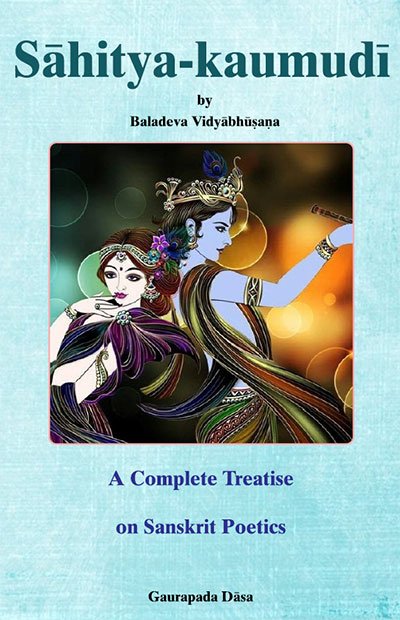Sahitya-kaumudi by Baladeva Vidyabhushana
by Gaurapada Dāsa | 2015 | 234,703 words
Baladeva Vidyabhusana’s Sahitya-kaumudi covers all aspects of poetical theory except the topic of dramaturgy. All the definitions of poetical concepts are taken from Mammata’s Kavya-prakasha, the most authoritative work on Sanskrit poetical rhetoric. Baladeva Vidyabhushana added the eleventh chapter, where he expounds additional ornaments from Visv...
Text 9.38 [sword diagram]
तत्र खड्ग-बन्धो यथा,
tatra khaḍga-bandho yathā,
Among the diagrams, this is an example of the sword diagram:
vīṇā-vāṇī sundarī-vṛnda-mukhyā khyātā sadbhir lakṣaṇaiḥ kuñja-devī |
vīkṣāñcakre mādhavaṃ bhāva-sārā rāsollāsāt kāpi taṃ phulla-nīvī ||
vīṇā—[is fascinating like] a lute; vāṇī—she whose speech; sundarī—of beautiful girls; vṛnda—among the multitude; mukhyā—the foremost girl; khyātā—known; sadbhiḥ—eminent; lakṣaṇaiḥ—by characteristics; kuñja—of arbors; devī—the goddess; vīkṣāñcakre—saw; mādhavam—Mādhava; bhāva—is love; sārā—she whose essence (or whose power); rāsa—of relishment (or of śṛṅgāra-rasa) (or of juice); ullāsāt—on account of an upsurge; kā api—some woman; tam—Him; phulla—is loose; nīvī—she whose girdle.
Some young woman is first in rank among beautiful women. She is known by eminent characteristics. Her speech is as fascinating as a lute. She is the goddess of pleasure groves. She has the power of love. When She saw Mādhava, Her girdle loosened due to an upsurge of rasa.
The Sword:
vīṇā-vāṇī sundarī-vṛnda-mukhyā
khyātā sadhir lakṣaṇaiḥ kuñja-devī |
vīkṣāṃ cakre mādhavaṃ bhāva-sārā
rāsollāsāt kāpi taṃ phulla-nīvī ||
